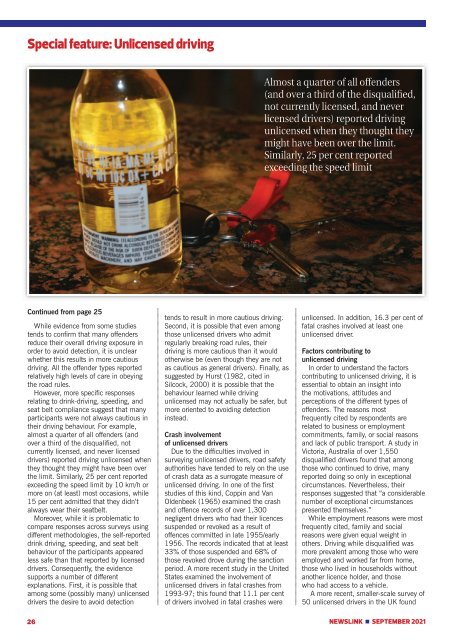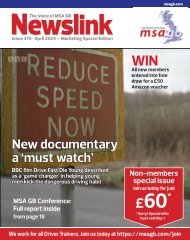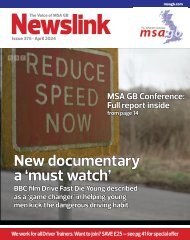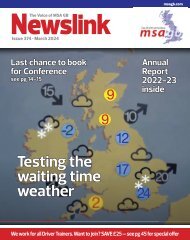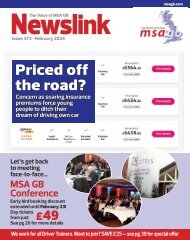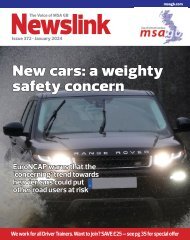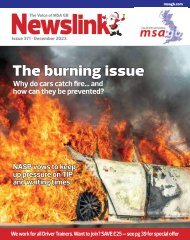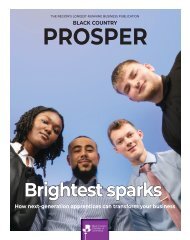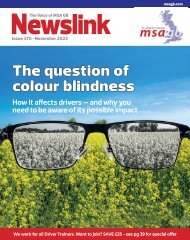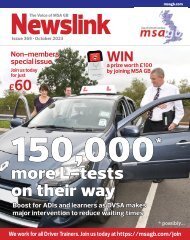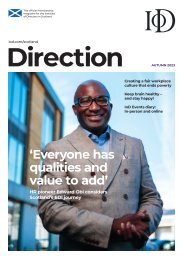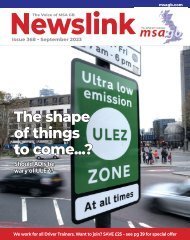Newslink September 2021
Motor Schools Association of Great Britain membership magazine; driving instructors, road safety, motoring news
Motor Schools Association of Great Britain membership magazine; driving instructors, road safety, motoring news
- No tags were found...
Create successful ePaper yourself
Turn your PDF publications into a flip-book with our unique Google optimized e-Paper software.
Special feature: Unlicensed driving<br />
Almost a quarter of all offenders<br />
(and over a third of the disqualified,<br />
not currently licensed, and never<br />
licensed drivers) reported driving<br />
unlicensed when they thought they<br />
might have been over the limit.<br />
Similarly, 25 per cent reported<br />
exceeding the speed limit<br />
Continued from page 25<br />
While evidence from some studies<br />
tends to confirm that many offenders<br />
reduce their overall driving exposure in<br />
order to avoid detection, it is unclear<br />
whether this results in more cautious<br />
driving. All the offender types reported<br />
relatively high levels of care in obeying<br />
the road rules.<br />
However, more specific responses<br />
relating to drink-driving, speeding, and<br />
seat belt compliance suggest that many<br />
participants were not always cautious in<br />
their driving behaviour. For example,<br />
almost a quarter of all offenders (and<br />
over a third of the disqualified, not<br />
currently licensed, and never licensed<br />
drivers) reported driving unlicensed when<br />
they thought they might have been over<br />
the limit. Similarly, 25 per cent reported<br />
exceeding the speed limit by 10 km/h or<br />
more on (at least) most occasions, while<br />
15 per cent admitted that they didn’t<br />
always wear their seatbelt.<br />
Moreover, while it is problematic to<br />
compare responses across surveys using<br />
different methodologies, the self-reported<br />
drink driving, speeding, and seat belt<br />
behaviour of the participants appeared<br />
less safe than that reported by licensed<br />
drivers. Consequently, the evidence<br />
supports a number of different<br />
explanations. First, it is possible that<br />
among some (possibly many) unlicensed<br />
drivers the desire to avoid detection<br />
tends to result in more cautious driving.<br />
Second, it is possible that even among<br />
those unlicensed drivers who admit<br />
regularly breaking road rules, their<br />
driving is more cautious than it would<br />
otherwise be (even though they are not<br />
as cautious as general drivers). Finally, as<br />
suggested by Hurst (1982, cited in<br />
Silcock, 2000) it is possible that the<br />
behaviour learned while driving<br />
unlicensed may not actually be safer, but<br />
more oriented to avoiding detection<br />
instead.<br />
Crash involvement<br />
of unlicensed drivers<br />
Due to the difficulties involved in<br />
surveying unlicensed drivers, road safety<br />
authorities have tended to rely on the use<br />
of crash data as a surrogate measure of<br />
unlicensed driving. In one of the first<br />
studies of this kind, Coppin and Van<br />
Oldenbeek (1965) examined the crash<br />
and offence records of over 1,300<br />
negligent drivers who had their licences<br />
suspended or revoked as a result of<br />
offences committed in late 1955/early<br />
1956. The records indicated that at least<br />
33% of those suspended and 68% of<br />
those revoked drove during the sanction<br />
period. A more recent study in the United<br />
States examined the involvement of<br />
unlicensed drivers in fatal crashes from<br />
1993-97; this found that 11.1 per cent<br />
of drivers involved in fatal crashes were<br />
unlicensed. In addition, 16.3 per cent of<br />
fatal crashes involved at least one<br />
unlicensed driver.<br />
Factors contributing to<br />
unlicensed driving<br />
In order to understand the factors<br />
contributing to unlicensed driving, it is<br />
essential to obtain an insight into<br />
the motivations, attitudes and<br />
perceptions of the different types of<br />
offenders. The reasons most<br />
frequently cited by respondents are<br />
related to business or employment<br />
commitments, family, or social reasons<br />
and lack of public transport. A study in<br />
Victoria, Australia of over 1,550<br />
disqualified drivers found that among<br />
those who continued to drive, many<br />
reported doing so only in exceptional<br />
circumstances. Nevertheless, their<br />
responses suggested that “a considerable<br />
number of exceptional circumstances<br />
presented themselves.”<br />
While employment reasons were most<br />
frequently cited, family and social<br />
reasons were given equal weight in<br />
others. Driving while disqualified was<br />
more prevalent among those who were<br />
employed and worked far from home,<br />
those who lived in households without<br />
another licence holder, and those<br />
who had access to a vehicle.<br />
A more recent, smaller-scale survey of<br />
50 unlicensed drivers in the UK found<br />
26<br />
NEWSLINK n SEPTEMBER <strong>2021</strong>


